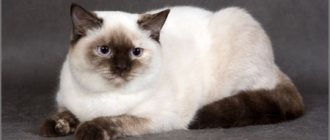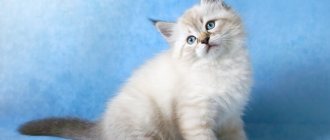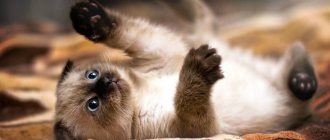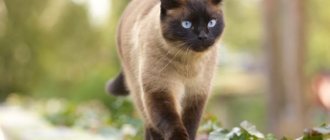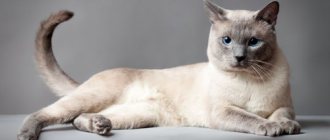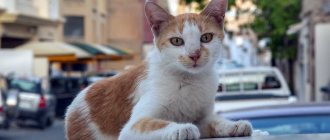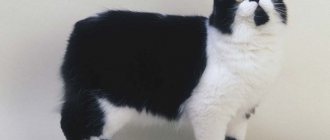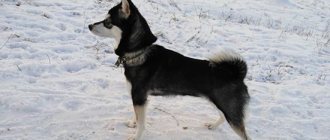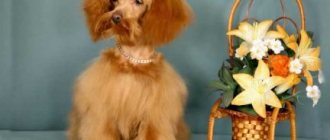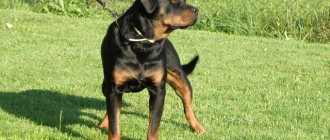1. Information about the Siberian cattery. Fairy Tale of Siberia is a nursery of Siberian cats of traditional color, located in Moscow. The nursery specializes in breeding Siberian cats with high pedigree characteristics. For questions about purchasing Siberian kittens from our nursery, call the contact number +7-926-780-80-18 or +7-985-895-48-85, you can also make a request by e-mail. In addition, you can always get from us consultations on the care and maintenance of cats and male cats of the Siberian breed. Our stud cats: [1] - male Angelur Bayun - Grand International Champion, [2] - female male Taimyr Simbirtsit of Angelur - World Champion.
- Purchasing a Siberian kitten from a nursery.
- Colors of the Siberian breed.
- Features of care and maintenance.
Cattery of Siberian cats - purchasing kittens.
2. Siberian cat. Do you need a kitten from the Siberian cattery ? Call: +7-926-780-80-18, our Siberian cattery offers you purebred Siberian kittens of traditional color. All our animals comply with international standards WCF, TICA, FIFe, CFA, IFF and have titled parents; accordingly, a pedigree is provided for each kitten. All kittens are exhibited upon reaching 12 weeks of age, after completing a course of vaccination, deworming and obtaining a veterinary passport. If necessary, you can reserve the kitten you like and then come to us to meet and examine the animal. For reservation conditions, please contact our nursery. When purchasing a kitten from our nursery, the following documents are drawn up.
- Veterinary passport.
- Metrics.
- Agreement on transfer of ownership of an animal.
Siberian breed.
3. The first mentions of the ancestors of the Siberian breed date back to the beginning of the 16th century. The formation zone of the Siberian population is considered to be the eastern part of the Urals and the territory of Western Siberia. A quick glance at the phenotype of Siberians is enough to draw a conclusion about the harsh climate that influenced the formation of the main distinctive characteristics of animals of this breed. Long hair and thick undercoat, powerful paws, and a muscular body are all distinctive features of a purebred Siberian cat, perfectly adapted to survive in the cold continental climate of Siberia. The weight of an adult cat varies in the range of 6-9 kilograms, some individuals reach a weight of 12-14 kilograms. The cat's weight is slightly less: 4-6 kilograms.
Bicolor
Two-color cats look original and quite bright due to the inclusion of snow-colored spots. The main color of the fur coat is plain or tortoiseshell. White should not occupy less than a third and more than half of the entire skin of the animal. The boundaries of colors must be clear.
Cats of this color sometimes have a very beautiful pattern, for example, white lining on the bottom, when the upper part of the cat’s body is colored, and the tummy and limbs are white. Often there is a spectacular pattern on the muzzle and collar, as well as snow-white “socks” and the tip of the animal’s tail.
INTERESTING TO KNOW: Cheerful and affectionate exotic cat
Cattery of Siberian cats - standardization of the breed.
4. When purchasing a kitten in our Siberian cattery, Fairy Tale of Siberia, familiarize yourself with the basic standards of the Siberian breed.
You can get detailed advice on the breed qualities of each animal offered for sale by calling +7-926-780-80-18. So, the standards of the Siberian breed. The first stage of standardization of the Siberian breed dates back to 1990, when the Soviet Felinological Federation approved the official breed standard, code designation SIB. At the same time, the standard for the subspecies of the Siberian cat was approved: Neva Masquerade - Siberian color point. 1992 - World Feline Federation - WCF registers the standard of the Siberian cat breed. 1996 and 1997 - inclusion of the breed in the register of TICA - American International Cat Fanciers Association and FIFe - European International Cat Fanciers Association.
Appearance
The general impression of the representative of the breed is that of a powerful, muscular animal, strong, well proportioned, and predominantly large in size. Cats are more miniature than cats . The requirements of the standards of felinological organizations for the condition of Siberian cats are as follows.
Body
The Siberian cat has a body of medium length, rectangular contour, dense build with well-developed muscle tissue, a powerful neck and a wide chest. The limbs are strong, of medium length, and form a triangle with the body. The paws are large, rounded, with noticeable tufts of hair between the toes. The tail is somewhat shorter than the body, up to the shoulder blades, wide at the base, slightly tapering towards the tip.
Head
A massive head in the shape of a wedge of medium length, tapering downward, with soft contours. The forehead is convex, low, smoothly transitions to the wide bridge of the nose. The cheekbones are full, well developed, and form a gentle arch.
The nose is of medium length with a depression noticeable in profile, which does not turn into a stop, and forms one line with the chin. Pillows with long vibrissae are rounded. The chin and lower jaw are well developed but not protruding.
Eyes
The eyes are large, almost round, set wide and well open. The outer corners are slightly extended towards the base of the ears. If the standards of all evaluating organizations are unanimous regarding form and position, then opinions regarding eye color are divided.
- According to FIFe and TICA regulations, all recognized colors are acceptable without any connection with coat color.
- The CFA standards narrow these requirements somewhat, indicating that color-point Siberian cats must have blue eyes, preferably with an intense tint.
- According to the WCF version, the eyes must be of a uniform color and match the coat color. In this case, any shades from golden yellow to emerald green are allowed. The exceptions are the Van and White colors: these cats can have blue or different colored eyes.
Ears
The ears are set wide apart and slightly tilted forward, of medium size, with rounded tips, well open at the base . The inner surface of the auricle is covered with decorative long hair. The FIFe and TICA standards allow tassels on the tips.
Wool
The guard hair of the back is hard, water-repellent, and falls to the sides and tail. The belly and the outer surface of the hind limbs do not have integumentary hair. The undercoat is double, very thick, dense, with a soft and fine texture, and does not adhere to the body.
The tail should be evenly “stuffed” on all sides with dense hair. In general, the coat is of moderate length, much shorter in summer than in winter. In the cold season, the decorative coat forms a lush collar on the shoulders and chest, a voluminous “feather” on the tail and fringes (panties) on the hips.
Colors
The standards adopted by felinological organizations allow for Siberian cats a variety of, sometimes quite exotic, colors and various combinations thereof. Exceptions are: Burmese, lilac, chocolate, their derivatives, as well as Abyssinian tabby. Conventionally, there are 3 main groups of colors - patterned (tabby), solid and acromelanic (color-point) .
The tabby color is characterized by:
- a longitudinal stripe on the back and two parallel stripes on the sides;
- closed ornaments in the form of a necklace on the neck;
- 2 rows of spots of the main color (buttons) on the belly;
- rings on the tail and limbs that are darker than the main color;
- M-shaped mark on the forehead;
- outlining the contours of the eyes and nose.
Tabby color has 3 main types of pattern:
- classic (marble) in the form of butterfly wings in the area of the shoulder blades and closed spirals on the sides;
- tiger (mackerel), which is an alternation of parallel light and dark stripes on the sides;
- spotted with a pattern of individual spots of different shapes and sizes.
If the coat does not have a residual pattern in the form of stripes, stains, or spots, it is a monochromatic (solid) color. For Siberian cats, only two true solid tones are distinguished: black and red. Blue is a lightened version of black, while cream is a lightened version of red. Standard requirements for black, blue and cream solids:
- the color should be rich, evenly distributed from the root to the tip of each hair, without a residual pattern;
- the undercoat should not differ in color from the guard hair;
- White medallions, buttons, gloves, and stains are not acceptable.
For red solids, the letter M on the forehead and a residual tabby pattern on the paws and body are allowed. When the genetic “overlay” of monochrome red on black results in a black-red tortoiseshell color (tortie) - black and red spots evenly distributed throughout the coat.
The action of the clarifier on both initial color components leads to the formation of a blue-cream tortoiseshell color. Various combinations of one of the patterns and pigment densely distributed in the coat give a variety of variations in the colors of the Siberian cat. The standards contain the following names:
- black marbled, black tabby, black brindle, black spotted;
- as well as red, blue, blue-cream, tortoiseshell with all types of patterns (red tabby, red marble, red brindle, red spotted and so on according to the same principle).
The agouti factor is responsible for the chinchilla color, when each hair is colored with alternating light and dark rings . But unlike tabby cats, an individual chinchilla hair has only two stripes - light at the root and dark at the tip. This color, rare for Siberian cats, has two varieties: shaded and veiled.
With a silver chinchilla color, only the upper part of the guard hairs is pigmented, while their bases and undercoat remain white. When silver is applied to solid or its lightened version, a smoky color with the appropriate name is obtained, for example, black smoke or blue-cream smoke.
This is interesting! The names of patterned silver colors will reflect the presence of one or another tabby effect: for example, blue silver merle or blue cream silver tiger.
Until now, breeders continue to work on breeding Siberian cats of golden color, when each guard and integumentary hair is partially colored apricot color:
- from 1/2 part for golden tabbies;
- up to 2/3 of the golden shaded part;
- approximately 7/8 of the golden chinchillas.
White color of Siberian cats is also quite rare. The requirements of the standards in this case are the same as for solids: the color is distributed evenly and without including spots of other colors throughout the body; tabby patterns are unacceptable.
Information about the main types of complex colors with white spots is presented below.
- Color type: Nonspecific white spotting Ratio of spots to surface: Insignificant number of buttons, individual hairs on the body Localization of colored areas: Main part of the coat
- Color type: Bicolor Ratio of spots to surface: 30 -75% Localization of colored areas: Head (except for the triangle on the muzzle), shoulders, back, sides, tail
- Color type: Harlequin Ratio of spots to surface: 75 - 90% Localization of colored areas: Fragmentary on the head, shoulders, back, hips, tail completely colored
- Color type: Van Ratio of spots to surface: 90-97% Localization of colored areas: 2 spots behind the ears, tail completely colored
The Neva Masquerade is a color-point Siberian cat, which is characterized by:
- the most intensely colored ears, paws (gloves), tail;
- dark mask on the face;
- light body and limbs.
Depending on the pigment of the point, the main colors of Neva masquerade cats are distinguished:
- seal point;
- blue point;
- red point;
- cake point.
These options can be combined with tabby patterns and silver shades.
The standards impose the following requirements:
- the presence of a clear boundary between the points and the overall tone of the body;
- uniformity and equal intensity of coloring of points on the face, paws and tail;
- absence of dark spots on the abdomen.
Return to content
Character of the Siberian cat.
5. Representatives of the Siberian breed are distinguished by their devotion and nobility. By nature, they are born leaders who get along well with people and other animals. The presence of wild Asian cats among the ancestors of Siberians determines well-developed hunting instincts. Siberian cats are one of the most intelligent breeds and are highly trainable. Despite their impressive and menacing appearance, Siberians are distinguished by their complacency and sincere affection for their owner. At the same time, these are unobtrusive animals and don’t mind spending time alone on the couch. Another distinctive feature of Siberians is cleanliness and accuracy. Physiological characteristics of the breed: good health, resistance to disease, physical strength and endurance.
Siberian health, Caucasian longevity
As true natives of Siberia, representatives of the breed are distinguished by excellent health and longevity. You may be surprised to learn how long Siberian cats live: in optimal conditions they reach an age of 13-17 years, but in many cases they live up to 19 years or more. However, due to improper care and feeding, animals can be infected with parasites, have problems with teeth and gums, develop allergies, diseases of the gastrointestinal tract and even heart pathologies. Therefore, we once again remind you of the need to provide your pet with a nutritious diet and a healthy drinking regime, as well as take care of vaccinations and timely treatment against helminths.
Good to know: Siberian cats not only have good health, but are also considered hypoallergenic. This is due to the fact that the animal’s saliva contains a minimal amount of Fel d1 protein: experts have found that it is this protein, and not cat fur, that causes people with allergies to sneeze, cry and choke.
Caring for a Siberian cat.
| Letter designation / Color name |
| a - blue |
| b - chocolate |
| c - lilac |
| d - red |
| e - cream |
| f - black turtle |
| g - blue turtle |
| h - chocolate turtle |
| j - purple turtle |
| n - black |
| o - cinnamon |
| p - faun |
| q - cinnamon turtle |
| r - fawn turtle |
| s - silver |
| w - white |
| y - golden |
| Additional information about color | |
| Bicolors, colors with white / Bicolour (Solid and white) | |
| 01 | van / van |
| 02 | harlequin / harlequin |
| 03 | two-color / bicolour |
| 04 | mitted |
| 05 | snowshoe pattern |
| 09 | presence of white / unspecified amound of white |
| Drawing/ Tabby colors | |
| 11 | shaded |
| 12 | veiled/shell |
| 21 | tabby / unspecified tabby pattern |
| 22 | marbled / blotched |
| 23 | brindle / mackerel |
| 24 | spotted / spotted |
| 25 | ticking / tabby ticked |
| 31 | Burmese color / burmese colors |
| 32 | Tonkinese color / tonkanese colors |
| 33 | Siamese color / siamese colors (pointed / himalayan) |
6. In the photo: a kitten from the Siberian cattery “Fairy Tale of Siberia”. Some tips on caring for and maintaining a Siberian cat. The long, thick coat and undercoat are one of the distinctive features of this breed and require regular grooming. The kitten should be immediately accustomed to periodic brushing. At the same time, pay attention to the material from which the brush or comb is made - when it comes into contact with your pet’s fur, it should not lead to the generation of static electricity. Static has a negative effect on the cat's fur, the hairs become brittle and brittle, and then fall out easily. Before purchasing a kitten from a nursery, you should make sure that you have all the necessary accessories: a tray, a nail polish, cups and saucers for food, items for caring for your pet. For more detailed information on the care and maintenance of a kitten, you can contact the owner of the Siberian cattery by calling +7-926-780-80-18.
Care and maintenance
Caring for a Siberian cat is very simple if it is kept in a private house in nature. In such conditions, the pet lives at ease and takes care of itself. When living in an apartment, long-haired pets need to be brushed regularly once a week. During shedding in spring and autumn, you need to remove dead hair daily. The entire procedure for caring for and maintaining a pet comes down to traditional simple manipulations:
- With regular brushing from a very early age, the animal gets used to it, and the kitten may even like it. The fur of Siberians has the property of not matting or matting, so painful sensations when combing can be avoided. To do this, purchase a wide flat brush with a double-sided purpose, a comb with rare teeth, it is best to use a furminator.
- While still in the nursery, the kitten quickly learns to use the litter box. The container should be wide and deep, because Siberians grow to enormous sizes. To prevent the filler from clinging to long hair and fluffy paws, it must be large and hard, and most importantly, clean.
- You should not bathe your cat, only after a walk wash and dry its paws and wash its organs. The only exception when special care is required for a Siberian cat is when walking outside; you need to wash your paws after each walk. To wash and eliminate cat odor, use a special dry cleaning powder.
- For domestic cats, the hair between the toes is trimmed to make it easier to keep their paws clean.
- Regular use of malt paste will help remove hair (trichobezoars) from the stomach, which accumulates during licking.
- Once a month, clean the ears from dirt and wax with sanitary sticks carefully moistened in an antiseptic solution without alcohol and clean the eyes with a damp cloth if there is discharge.
- Siberian cats do not have their claws cut; it is enough to have a scratching post. To provide your pet with a comfortable place to play and relax, purchase a multi-level complex with a scratching post.
- For summer walks, the wool is treated with special products against fleas and ticks, and a collar impregnated with parasites is worn.
Siberian cats video
Important! For people suffering from allergy attacks, it is advisable to check the reaction to the allergen from fur and sweat before purchasing a Siberian cat.
Diet
Feeding Siberians at home is not difficult. They are descendants of animals raised in nature and prefer simple, varied food. Breeders and veterinarians advise feeding your pets using home-cooked food from a varied selection of natural products. Which should include:
- Lean meats and poultry, rabbit, pork should be excluded. The products are frozen, chopped and given to animals at the rate of 70 - 100 grams per day.
- By-products from poultry and meat such as: heart, stomachs, udder, liver, tripe are boiled, ground and normally 70 - 100 grams per day alternated with meat.
Important! Liver is offered to light-colored cats only twice a month.
- 4. Low-fat cod fish (hake, cod, pollock) are boiled and boneless in the amount of 50 grams twice a week.
- Chicken quail eggs are boiled and mixed with meat along with the yolk 1-2 times a month.
- Be sure to give fermented milk products 2-3 times a week: sour cream, kefir, cottage cheese, exclude whole milk.
- Porridges from various cereals in water, including beans, peas and lentils boiled to a puree consistency, add 50 g to the meat.
- Boiled or chopped raw vegetables and herbs are added at least 1-2 times a week.
- Place a large bowl of clean bottled water next to your pet's food.
Important! Be sure to add a vitamin complex to your food daily on the advice of your veterinarian.
When feeding your pet, follow simple rules:
- food at room temperature is given at the same time in one familiar place, the dishes are kept clean;
- feed an adult cat 2 times a day;
- the volume of food should correspond to approximately 30–60 g per 1 kg of cat weight;
- The food composition must contain at least 60% proteins, 30% carbohydrates and 10% fats; this is a sufficient amount of nutrients, plus vitamins and minerals.
If necessary, a Siberian cat can be switched to ready-made factory food. But it is selected according to the age and physiological state of the pet. Food must be premium and super-premium.
Health and diseases
The Siberian cat breed has good health; the descendants of those raised in the natural conditions of the harsh climate of Siberia, they do not have a predisposition to colds and genetic diseases.
For their development and growth, the main thing is to maintain a proper balanced diet and maintain minimal care and maintenance. With timely vaccination and helminth prevention, there are no major threats to the health of Siberians.
In cats, hair can get into the intestines.
Problems usually come with age:
- with the gastrointestinal tract, caused by poor digestion;
- with heart disease, shortness of breath, slowness, lethargy, and cough appear;
- Urolithiasis often leads to kidney failure.
Important! When the first symptoms of disease appear, it is recommended to seek advice and treatment from a veterinarian.
How many years do Siberian cats live?
Large and well-developed cats of the Siberian breed have fairly good immunity, inherited from their ancestors who lived in the harsh taiga climate. Kittens mature up to 5 years old, but in general the breed is considered to be long-lived compared to other cats.
The average lifespan of a Siberian cat can reach 17-20 years, but with proper care and a balanced diet they can live 20-25 years. This is explained by the lack of hereditary, genetic predisposition to certain diseases.
Important! The life expectancy of a Siberian cat is well influenced by care for the psycho-emotional state of the pet and the attention of the owner and family. They show love, affection, and involve the pet in active joint games.
Vaccination of kittens in our Siberian cattery.
7. All kittens from our Siberian cattery undergo mandatory vaccination at 2 months of age, with the issuance of a veterinary passport, which contains information about the animal’s vaccinations. After the primary vaccination, revaccination is carried out after 3-4 weeks. After revaccination, a 2-week quarantine is required, during which the kitten’s contact with other animals, street clothes and shoes is limited as much as possible. Primary vaccination is aimed at developing immunity against the pathogens of the following diseases: [1] calicivirus, [2] rhinotracheitis, [3] panleukopenia. Revaccination is carried out to form immunity against the same diseases and additionally against rabies. Before primary vaccination, it is necessary to undergo a 2-week course of treatment for worms.
Health and illness
Cats of this breed live on average 10-13 years. If a pet receives proper nutrition, has vaccinations, and proper care, it can live much longer, up to 20 years or more. The masquerade breed has strong immunity and generally good health from birth.
They most often suffer from diseases that also occur in other felines, such as cardiomyopathy. The disease may not manifest itself in any way in childhood, but become noticeable only with age and even cause sudden death.
Advantages of our Siberian cattery.
8. Briefly about the main advantages of our Siberian cattery “Fairy Tale of Siberia”.
• High breed characteristics of kittens. • Manufacturers have the titles of World Champions and Grand International Champions. • Well-organized kitten care. • The kittens have an excellent pedigree. • Extensive experience in breeding work in collective nurseries of the Siberian breed. • Opportunity to receive advice on almost all issues related to the maintenance and care of a Siberian kitten from our • nursery. • Flexible and affordable prices for kittens.
For all questions related to information support, reservation and purchase of purebred kittens with a pedigree from our Siberian cattery, call the contact number: +7-926-780-80-18. Geographically, the nursery is located in Moscow.
Solid colors
A Siberian cat from this group has a uniform coat color without spots, stripes or tan marks. The complete absence of a pattern on the fluffy fur coat of a fluffy Siberian is called a solid color, or solid. Each hair of a cat's fur from this group is evenly dyed along its entire length. The eyes of these animals are often copper or amber in color, although such a beautiful color as blue is also found.
Within the group there are several more subgroups into which animals with different coat colors are defined:
- Blue. This is one of the most popular and attractive colors in this cat breed. The Siberian Blue is distinguished by a specific “blue” tint of gray, ash-colored coat, which, in combination with increased fluffiness, creates very beautiful tints of color. Thanks to its docile but independent disposition and visual attractiveness, the Siberian Blue breed of local cats has become known and popular throughout the world. The fur of the beauties of this group can have different shades, but according to the standard, any pattern on it is excluded.
- White. The cat is pure, without the slightest admixture of other colors. It is dazzlingly beautiful and, for non-specialists, looks very similar to such a popular breed as the Turkish Angora. These animals often have beautiful blue eyes, but it should be remembered that such a cat is deaf. The combination of white fur and blue iris is a hereditary recessive trait, “linked” to the deafness gene. But this color option is often characterized by heterochromia - different eye colors. This is very beautiful and unusual against the background of the sugar-white coat, and one blue eye does not entail deafness. These cats have a soft pink tip of the nose and a similar shade of paw pads. Unlike Angora cats, these cats were formed in our rather harsh climatic conditions and are less capricious, although caring for coats of this color can be quite troublesome.
- Red. For ordinary people, this is more likely a red cat, but according to the standard the color is called that way. Such an animal looks stunning - a large animal of bright, simply blazing colors with eyes that match its luxurious fur coat. The coloring of the cats is uniform, without the pattern characteristic of ordinary “ginger” cats.
- Black. According to the standard, the animal must be completely black down to the pads of the fingers and the tip of the nose. This is a very beautiful cat, which is often confused with other breeds, since many do not know that “Siberians” can have this color option.
INTERESTING TO KNOW: Serval cat: how to keep a mini cheetah at home
